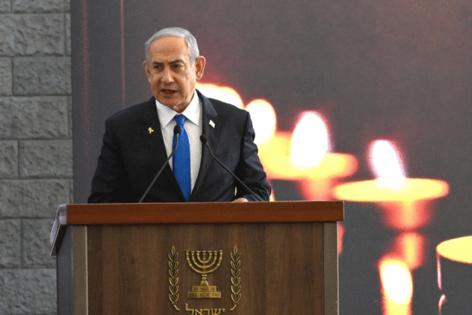Israel, Lebanon agree to ceasefire
Published in News & Features
AMMAN, Jordan — President Joe Biden on Tuesday announced Israel and Lebanon have reached a ceasefire agreement meant to pause fighting between Israel and the Iran-backed Hezbollah.
The 14-month conflict has left more than 3,000 people dead.
“Effective 4 a.m. tomorrow local time the fighting across the Lebanese-Israeli border will end. Will end,” Biden said from the White House. “This is designed to be a permanent cessation of hostilities. I applaud the courageous leaders of Lebanon and Israel end the violence.”
Israeli Prime Minister Benjamin Netanyahu said earlier Tuesday he had recommended that this government approve the agreement.
Though the deal does not involve the separate conflict in Gaza Strip, Biden administration officials said they hoped it would lead to an agreement to end fighting there, too.
Even as the deal was finalized, Israeli warplanes launched a series of airstrikes across Lebanon, striking areas in the country’s southern and eastern regions, along with the suburbs of the capital — areas where Hezbollah holds sway.
Several airstrikes also hit the heart of Beirut, killing at least 10 people, according to Lebanon’s Health Ministry.
In a televised address on Tuesday evening local time, Netanyahu said he would present the outline of the proposal to the government, pushing his ministers to accept the move despite reservations from far-right leaders who are integral members of his coalition.
“The length of the ceasefire will depend on what happens in Lebanon,” Netanyahu said. He added that Israel would maintain freedom to act against violations.
“If Hezbollah breaks the agreement and seeks to arm itself, we will attack,” he said.
The agreement would not immediately affect the fighting in Gaza Strip with the Palestinian militant group Hamas.
Netanyahu pushed his ministers to accept the agreement, arguing it would allow Israel to focus its attention on the threat from Iran, give Israeli troops an opportunity to replenish their stocks and isolate Hamas.
The agreement will initiate a 60-day truce that would see both sides withdraw: Israeli troops out of south Lebanon to Israeli territory, and Hezbollah to areas north of the Litani River, some 18 miles north of the Lebanese-Israeli border. During the truce, a monitoring mechanism would be established that would ensure Hezbollah is not able to reconstitute itself or wage attacks on Israel from southern Lebanon. A U.S.-led committee would oversee implementation of the withdrawal.
Lebanese officials say some 5,000 soldiers from Lebanon’s army — which has remained neutral during the conflict — would then enter south Lebanon, along with U.N. peacekeeping forces.
Lebanon’s caretaker government is set to meet Wednesday morning to discuss the proposal; it is widely expected to be approved.
Despite the optimism, many elements of the ceasefire proposal — which came about after vigorous negotiations brokered by the U.S. and France — remain unclear.
One of the larger sticking points is whether Israel would be able to continue striking Hezbollah throughout Lebanon if the group attempts to reestablish a presence south of the Litani River, or if it continues to wage attacks on Israel or smuggle weapons.
Israeli Defense Minister Israel Katz told the U.N.’s Lebanon envoy Jeanine Hennis-Plasschaert on Tuesday that Israel would act “forcefully” against any breach of the ceasefire agreement.
“If you do not act, we will do it, forcefully,” Katz said in a statement. “Any house rebuilt in south Lebanon and used as a terrorist base will be destroyed, any rearming or terrorist organization will be attacked, any attempt at transferring arms will be foiled, and any threat against our forces or our citizens will be immediately eliminated.”
Lebanese leaders have dismissed such an agreement as an unacceptable breach of Lebanon’s sovereignty.
The ceasefire would officially be an agreement between Israel and Lebanon. It includes a Lebanese lawmaker who has been negotiating on Hezbollah’s behalf. But Hezbollah, a paramilitary faction and political party which is backed by Iran, is not officially a party to the agreement.
Another question is the fate of Hezbollah’s weapons. Before the war, the group was considered one of the world’s premier paramilitary factions, with an arsenal more powerful than that of the Lebanese army. The ceasefire agreement, which is based on a U.N. resolution that established a ceasefire in the 2006 war between Hezbollah and Israel, has provisions that would force the group to surrender its arms.
A ceasefire would end a 13-month conflict that began a day after Hamas attacked southern Israel, when Hezbollah initiated a rocket campaign in northern Israel in solidarity with Palestinians in Gaza.
In the months of tit-for-tat strikes that followed, some 60,000 people from northern Israel and approximately 100,000 Lebanese from southern Lebanon were displaced.
In September, Israel escalated its attacks, conducting thousands of airstrikes on Hezbollah-dominated parts of the country and starting an invasion that saw Israeli troops enter southern Lebanon for the first time since 2006. It also assassinated Hezbollah chief Hassan Nasrallah.
Since Oct. 8, 2023, more than 3,823 people have been killed in Lebanon and 15,859 injured, according to Lebanese government data, the majority of them in the last two months. More than 25% of those killed were women and children, according to the government data, which do not distinguish between civilians and combatants.
Meanwhile, some 1.2 million people — almost a quarter of Lebanon’s population — have been displaced, with wide swaths of the country destroyed.
The Israeli government said on Tuesday that 78 Israelis have been killed in attacks by Hezbollah and its allies, including 47 civilians.
Even as senior Israeli ministers were meeting at Israeli military headquarters in Tel Aviv, Israeli warplanes launched some 180 airstrikes across the country, according to a statement from Israel’s military. It issued evacuation warnings for some cities. The military said it was targeting Hezbollah’s infrastructure, including the group’s financial arm.
Among the targets were four neighborhoods of central Beirut with which had previously been spared from the fighting.
One raid hit Hamra, a popular shopping district in the capital which in recent months has become a sanctuary for hundreds of thousands displaced from the Dahieh, the constellation of suburbs south of Beirut where many of Hezbollah’s offices are headquartered.
The Dahieh too was pounded by an intense barrage of more than 20 airstrikes, leaving the area obscured by a curtain of smoke and rocking buildings in adjacent neighborhoods.
“The hysterical Israeli aggression this evening on Beirut and various Lebanese regions, which specifically targets civilians, confirms once again that the Israeli enemy does not respect any law or consideration,” said Lebanese caretaker Prime Minister Najib Mikati in a statement on Tuesday. He called on the international community “to act quickly to stop this aggression and implement an immediate ceasefire.”
Meanwhile, Hezbollah continued its barrage against northern Israel, lobbing dozens of projectiles across the border.
_____
©2024 Los Angeles Times. Visit at latimes.com. Distributed by Tribune Content Agency, LLC.







Comments